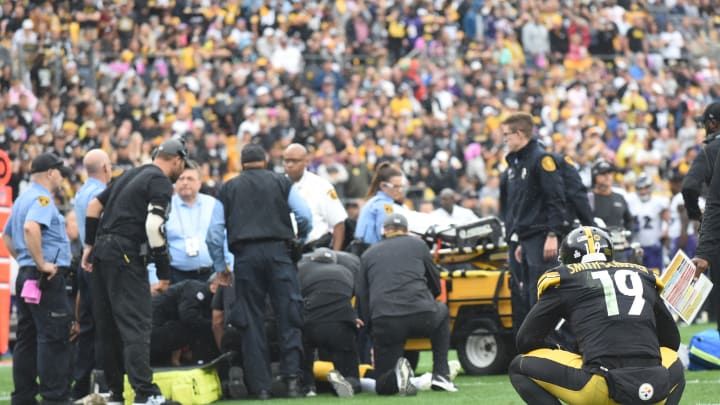The NFL should adopt the NCAA's 'targeting' rule to prevent helmet-to-helmet hits

Football is a violent game. Arguably the most violent game in the world today. When the players of the NFL, NCAA, high school, or even Pop Warner leagues step onto the field, they are all at risk to serious injuries.
Anyone who is a football fan knows exactly why they love the game. As a fellow fan of football myself, I always want to see the game played in its purest form.
I want to see the Patrick Mahomes’s of the world make incredible throws. I want to see electric running backs like Barry Sanders and LaDainian Tomlinson run with the football like we’ve never seen before. I want to see players that have the amazing combination of athleticism and instinct like Troy Polamalu did.
What I don’t want to see is players knocked unconscious; watching the life of a human being instantly leave his body as it limply falls to the ground.
Mason Rudolph is the latest victim of a violent hit to the head.
In Sunday’s game between the Steelers and Ravens, Rudolph scrambled on a crucial 3rd-and-11 play and connected with receiver James Washington for a 26-yard gain. Baltimore safety Earl Thomas zoned in on Rudolph to make a play, in which the crown of his helmet made violent contact with Rudolph’s jaw, knocking him unconscious instantly.
Mason Rudolph knocked unconscious. #BALvsPIT pic.twitter.com/rWkF1YfZRT
— Rob Lowder (@Rob_Lowder) October 6, 2019
There didn’t appear to be malicious intent by Thomas. He spoke to the media about the hit after the game, claiming there was no intention of trying to hurt the young quarterback.
Earl Thomas on his hit that knocked Mason Rudolph out of the game: "I didn’t try to intentionally hurt him. I’m worried about him. I heard he’s at the hospital. My prayers go out to him and his family" pic.twitter.com/axAewwJNI3
— Post-Gazette Sports (@PGSportsNow) October 6, 2019
Here lies the problem. This hit could have been, and should have been prevented.
In recent years, the NFL has had serious issues with continuous hits to the head. And the more we learn about the dangers of multiple concussions and CTE (Chronic Traumatic Encephalopathy), the more us fans of the game want to emphasize player safety.
The NFL has made certain strides to improve player safety, but some of them seem counterproductive to the actual problem. The NFL did implement stricter rules for hits on defenseless receivers, but have also increased the emphasis on protecting quarterbacks to a laughable state.
NFL officials remain horribly inconsistent with how they call "roughing the passer" in games, and it's come in crucial moments too often. The bad calls have had a direct effect on the field, stripping away the integrity of the game in the process.
Sure, the league wants to protect quarterbacks. They're the money makers. They are the most important players on the field, who touch the ball every single snap. There's a reason why the majority kids want to play quarterback when they grow up.
Here's the bottom line: All players should be protected, not just quarterbacks.
It's a fine line to walk when we begin to talk about how to solve the problem of protecting players without compromising the integrity of the game. It's not an easy conversation either. The game moves faster than it ever has before. Athletes are bigger, stronger, and faster than they've ever been. The game is also the most complex it's ever been. Teams are throwing the ball more than ever, leading to more potential violent hits down the field.
When players are in an all-out sprint towards each other, making last-second adjustments to avoid contact is nearly impossible. There are even times when a receiver has to make a last-second adjustment to a pass, leaving the defender with no time to react and avoid an illegal hit. Former Steelers safety Mike Mitchell explained his frustrations about situations like this in 2017.
Mike Mitchell absolutely killing it. Must watch. @TheAthleticPIT pic.twitter.com/SwcvJMJyHy
— Mark Kaboly (@MarkKaboly) December 6, 2017
That's not fair. Mike Mitchell absolutely has a valid point.
Life, however, isn't fair. And the NFL is past the point of what's fair. Headshots are still a big problem and the league has to come to a breaking point. If they truly care about player safety, stricter rules have to be implemented.
The league just now handed Vontaze Burfict a season-ending suspension after a career of multiple, repeated illegal hits to the head. I understand the players, like Mike Mitchell, getting upset when there's no guideline in place. There's no policy. It's all at the discretion of Roger Goodell. It's literally a dictatorship.
This is why I propose the NFL adopt the NCAA's "targeting" rule. It's drastic, strict, but as fair as it can possibly be. Will players still get punished for hits because of situations like Mitchell described? Yeah, probably. But the majority of hits can possibly be taken out of the game that don't belong.
If you're unfamiliar with the penalty, "targeting" is an illegal hit to the head/neck area that can either be called on the field or be called after a replay review. All potential targeting calls are subject to review. Indicators of targeting include:
- Launch — a player leaving his feet to attack an opponent by an upward and forward thrust of the body to make forcible contact in the head or neck area
- A crouch followed by an upward and forward thrust to attack with forcible contact at the head or neck area, even though one or both feet are still on the ground
- Leading with helmet, shoulder, forearm, fist, hand or elbow to attack with forcible contact at the head or neck area
- Lowering the head before attacking by initiating forcible contact with the crown of the helmet.
Currently, a player that is called for targeting is ejected for the remainder of the game. If the penalty is called in the second half, they are disqualified for the first half of the subsequent game.
The targeting rule goes back to 2008 for NCAA football. Players were then subjected to ejections/disqualifications in 2013, and in 2016, the replay official became involved in the decision making process.
The NCAA struggled with this rule at first, calling too many penalties that were deemed "ticky-tack" by Bill Corollo, the Big Ten's coordinator of football officials. The way the rule has been enforced up until 2019 is if the replay officials could not confirm whatever the call on the field was, targeting or not, the call would stand. This led to a lot of "gray area" targeting calls that angered many coaches, players, and fans.
To avoid these types of calls, now the officials have to confirm targeting occurred on the play (based on the indicators listed above). If they cannot, targeting will not be called.
So, if targeting was called on the field, but after a second look they confirm there was no targeting, the flag will be picked up. It also works the other way. If a borderline hit is made, but no flag is thrown on the play, the replay officials can buzz down to the field officials to review the hit. If they find targeting occurred, they will enforce the penalty on the guilty player.
Obviously, this rule is in place in college football to eliminate headshots in games. The coaches and players are aware of what officials are looking for when calling targeting.
It's time the NFL moves on from Roger Goodell's inconsistent rulings on illegal hits and player safety. It's not fair to defensive players like Mike Mitchell. It's not fair to the offensive players getting hit illegally. It's not fair to the fans to watch inconsistent officiating water down the sport we all love to watch on Sundays.
Based on the NCAA's targeting rule, Earl Thomas would have been ejected for this hit on Mason Rudolph. It was a high hit where the crown of the helmet made a forcible impact with Rudolph's jaw.
But let's not think the Steelers are immune to hits like this. Bud Dupree made a late hit to the head of Russell Wilson in their Week 2 matchup with Seattle. No flag was thrown for an illegal hit. A rule like targeting, when properly enforced, would have ejected Dupree from the game. He was later fined for the hit.
Excuse me?!! pic.twitter.com/PkCPZS362J
— Dick Fain (@dickfain) September 15, 2019
Maybe the NFL could put their own spin on the rule. Maybe they go with an ejection and then the league goes to further review during the week to decide if any fines and/or suspensions are worthy.
Threatening players with ejections for illegal hits to the head, in a clear cut policy, is something the NFL needs to adopt. These players need to be protected from dangerous, violent hits to the head. All of the players. Not just quarterbacks.
We will never be able to fully take out headshots in football altogether. The game just moves too fast. But enforcing targeting could decrease the amount of times players suffer illegal hits to the head. And players like Vontaze Burfict might've suffered the strict suspension he was just handed much sooner.
If the NFL truly cares about reducing concussions, all options need to be exhausted. For the fans, but most importantly, for the players and their well-being.
